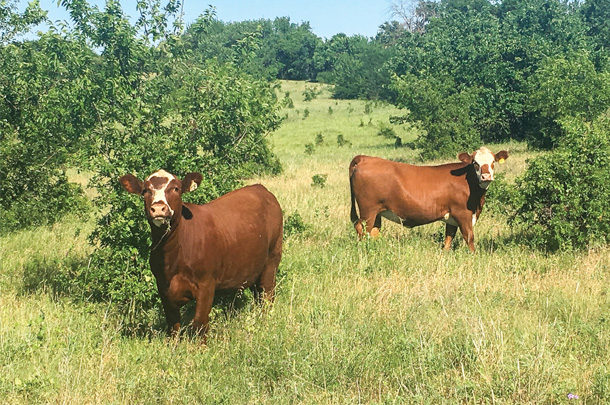Cattle will gain weight when nutrient intake meets metabolic requirements for a targeted average daily gain (ADG). This is true regardless of the feeding method, whether in a feedyard with grain and roughage or in a pasture with forage only. The latter obviously has fewer choices for feedstuffs, so managing both forage quantity and quality is the key to animal performance.
Confusion sometimes arises between terms like stocking rate and carrying capacity. Carrying capacity (how many animals) is a long-term average (probably over decades) for a ranch or a pasture. It can be used for things like long-term business planning. For example, a ranch for sale might advertise a carrying capacity of 100 cows yearlong. Planning for a grass-finished operation will require adjusting those cow numbers to make room for the finishing program.
So let’s assume an average 85% calf crop. If all calves are retained after weaning and finished on grass to yearlings, then cow numbers will need to be balanced with yearling numbers. A rule of thumb says two yearlings equals one cow. The actual math says about 40 fewer cows, depending on how long the yearlings will need to stay on pasture until they reach a target market weight. If they wean at 500 pounds and finish at 1,000 pounds, and have an ADG of 1.5 pounds, it will take about 333 days. Accounting for replacement breeding heifers and a couple of bulls, and probably bigger cow body size these days (1,300 pounds?), this “100-cow ranch” will run 52 cows and 36 yearlings over the long term.
Grazing pressure and stocking rate
In reality, stocking rate is what ranchers work with day to day. It is a moving target affected by weather, and it is the first tool that should be used to manage forage quantity. Essentially, a manager is trying to estimate: “How long can I graze ‘X number’ of animals in a pasture without harming plant or soil health?” This is especially critical during periods or seasons of low rainfall and slow or no plant regrowth. This can be done on native grasses by clipping and weighing or, if the person has experience, simply with an educated guess. (Texas A&M AgriLife Extension is presently developing a phone app that should soon be available to help with forage biomass estimates.)
The rule of thumb on native grasses is to “take half and leave half” for a grazing period. “Leaving half” protects the soil and aids in capturing rainfall into the soil, which in turn makes more moisture available to plants and soil organisms. Let’s say we’ve determined there is enough forage in a pasture to graze 36 head of yearlings averaging 700 pounds for four months – if no regrowth happens. If more animals are grazed, or if they are grazed for a longer period, they will continue to meet their daily forage intake needs. But now they are eating forage that was supposed to be left ungrazed to protect the soil and capture rainfall. Ecological condition will deteriorate over time relative to the severity of overgrazing.
Measuring grass stubble height is another way to estimate proper grazing pressure and stocking rate, particularly with introduced grasses like bermudagrass, where a minimum 4-inch average stubble height for a grazing period is recommended. It can also be useful on native grasses but must be adjusted for the species and type of grass (e.g., bunch versus sod). Grazing exclusion cages are another option to visually monitor stubble height and forage disappearance. There are many environments, especially in the southeastern U.S., where cool-season annuals like ryegrass can mitigate both forage quantity and quality challenges in winter.
More intense grazing systems may offer the potential to help manage both forage quantity (harvest efficiency) and forage quality (leaf-to-stem ratio). But managers must be competent and knowledgeable with the system and environment.
Adding supplements
Before animals can grow and gain weight, rumen maintenance requirements must be met, and associated microflora must be healthy. This requires about 7% crude protein (CP) in the diet at all times. Oilseed meals (cotton, peanut, soybean, etc.) are plant-based and can be used as natural protein supplements in most programs. Animal weight gain also takes extra energy in the diet. Plant components that provide energy include cellulose, hemicellulose and plant sugars. Cellulose and hemicellulose are the primary source of energy for grazing animals. Grain is high in energy but, of course, is not an option. Supplemental dietary fat, which has 2.5 times the energy value of corn, is restricted in many programs. Energy feedstuffs may be limited to certain types of molasses supplements, haylage or silage, crop byproducts like soybean hulls (high in digestible fiber) or forage plants such as good-quality oat, wheat or sorghum-sudan hays.
Limit grazing can be one way to minimize cost and improve efficiency of high-quality winter forages such as wheat, oats, clover, rye, triticale, etc. High-protein forages like alfalfa hay, or a pasture planted with high-quality winter annuals, can function as “protein supplements” by improving digestion of really low-quality forages. Limit grazing is one way to use these pastures as protein supplements while also improving their cost-to-benefit in the overall grazing program. When limit grazing, allow access for only a few hours per day, or a day on and then off for a day or two, to allow animals to graze and fill up on less-digestible grasses the remainder of the time.
Forage quantity changes, as does quality. Usually in situations where quantity is not limited but where quality may be low (e.g., dormant grasses), providing a feedstuff high in protein will be the first step in supplementation because of protein requirements for rumen function. If gain is still not adequate, and more energy is needed, these forages may need to be fed in larger quantity – or feedstuffs like silages or highly digestible fiber feedstuffs may need to be considered. Measure forage quality in both base forage and in any supplemental feedstuffs by sampling and laboratory testing. Measure forage quantity with above-mentioned methods. Monitor animal body condition and measure weight gain. Load bar scales have become reasonably inexpensive. The adage “you can’t manage what you don’t measure” certainly applies in a grass-finished program.












